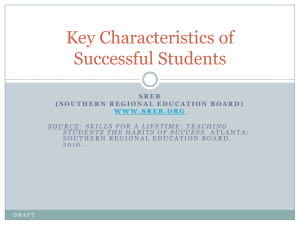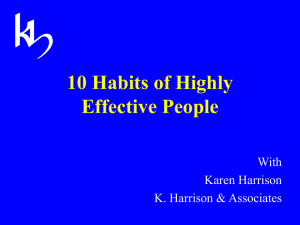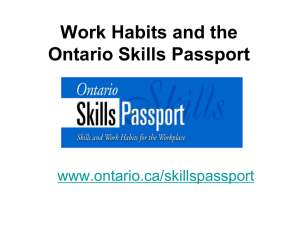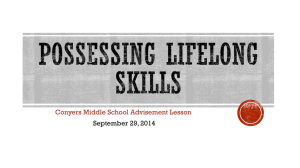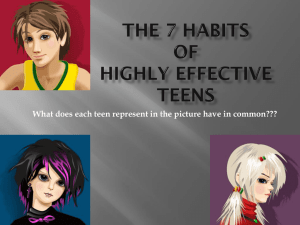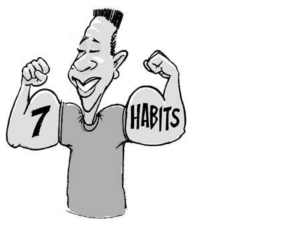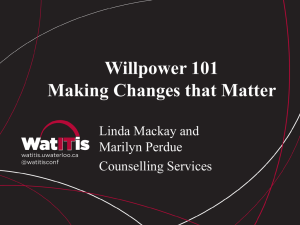what is a habit?
advertisement
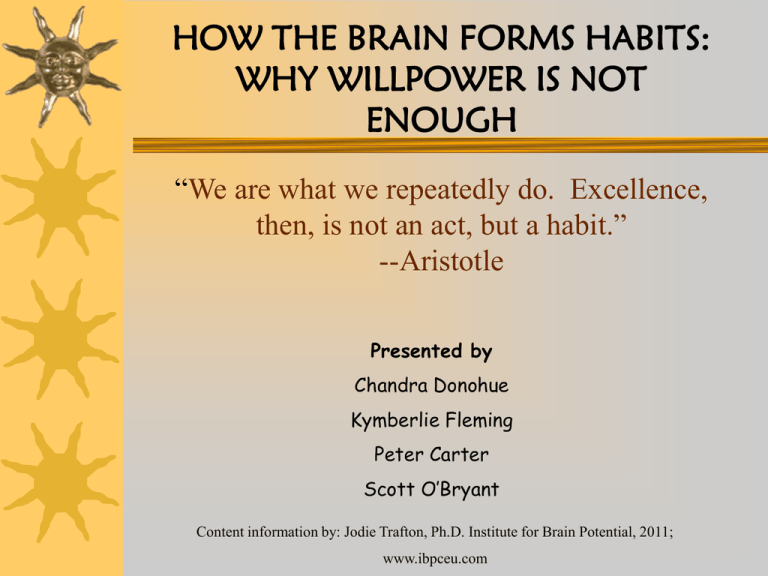
HOW THE BRAIN FORMS HABITS: WHY WILLPOWER IS NOT ENOUGH “We are what we repeatedly do. Excellence, then, is not an act, but a habit.” --Aristotle Presented by Chandra Donohue Kymberlie Fleming Peter Carter Scott O’Bryant Content information by: Jodie Trafton, Ph.D. Institute for Brain Potential, 2011; www.ibpceu.com WHAT IS A HABIT? •A regularly repeated behavior pattern •An action or pattern of behavior that is repeated so often that it becomes typical, although the person may be unaware of it. HOW IS A HABIT FORMED? Habits are formed over time, usually without our conscious intent allowing them to become ingrained. Habits are formed when the brain links specific behaviors with rewards. The more immediate the reward, the stronger the link. Repeating the reward will reinforce the habit. REWARDS Rewards are not just pleasure. A reward is an immediate improvement. Lessening of distress, pain, or anxiety will ingrain a habit just as strongly as a pleasurable reward. BAD HABITS •Bad habits cause immediate rewards but long-term harm. •Good habits must replace bad ones •Depriving yourself of rewards makes the brain seek them even more. HOW OUR BRAIN VALUES SOMETHING Rewards are linked to behaviors. We can overvalue habits that have been linked to other rewards like pretty faces, symbols of power, successes or relief. Classic example in advertising ROLE OF THOUGHTS & EMOTIONS Our beliefs and thoughts influence every aspect of our behavior. The more awareness we have of our thinking, the greater control we have over our behavior. Situation or Event Behavior /Habit Thinking Emotion Consequence STYLES OF DISTORTED THINKING Filtering Catastrophizing Personalization Overgeneralization Emotional Reasoning Control Fallacies WORK ON YOUR THOUGHTS TO ACHIEVE SUCCESS Thinking through our motivation, what we value, where we want to be. Recognizing distortions of thought within ourselves. Reframing: for each form of distorted thinking, come up with a disputation. Retrain the Brain: practice substituting distorted thoughts with more accurate disputations. WHAT MAKES CHANGING HABITS DIFFICULT?? Habits become deeply ingrained over time and the brain almost automatically initiates patterns of behavior in response to various stimuli. Without a clearly defined plan or strategy, very little chance for success. Modify expectations for results (gradual progress is more likely than immediate success). SET ACHEIVABLE GOALS •Awareness is the first key •Link your new habits to your LONG TERM values and goals •Use the awareness of your long term goals (willpower) to change your own reward values PAVE THE WAY FOR SUCCESS •Track •Avoid •Replace •Observe SMALL GROUP EXERCISE Break into groups of five You will be assigned a bad habit on your handout and make a plan to change it. -What steps will you take to change the habit? -How long will it take? -What will you do to prevent failure? WHY IS WILLPOWER NOT ENOUGH? “Habit is habit, and not to be flung out of the window by any man, but coaxed downstairs a step at a time.” - Mark Twain Willpower is great for increasing perseverance through a difficult task, but is not great for preventing you from doing bad habits. Why? How can willpower help? How does conscious thought modify the process? ENABLING HABITS Solicitous Spouse EffectOne study showed that people who deal with chronic pain experience a measurable three-fold increase in their experience of pain when they have a ‘solicitous spouse’ present who typically dotes on their pain. THEN WHAT DEFINES “HELPING” ANOTHER? The report explained that “Through the feedback loops of a marriage or long partnership, the patient’s pain has shaped the helping behavior of the solicitous spouse, who in turn has become a stimulus to provoke the pain.” SECONDARY GAIN Doting, rescuing or attending primarily to negative responses can reinforce bad habits in others Providing attention, relief, or rescuing people when they feel bad or respond inappropriately can reward bad responses and make them habitual These rewards can turn a negative response into a habit If we are rewarded for doing things that make us feel bad, we tend to feel bad! HABITS ARE CONTAGIOUS •We are preprogrammed to mimic/model the behavior of those we surround ourselves with. •Slang •Fads •Food •Cigs Visualization The Brain Cannot Tell The Difference Between a Real and an Imagined Action •Mirror neurons fire when we are observing others do something, even if we are not involved•helps pave the way for our own learning of said task. •Mimicking those around us •The closer the person is to you and the more you respect them, the more you will adopt their habits (both good and bad) Guided Imagery practicing/imagining the new behavior can help us speed the learning of it. Visualizing the action strengthens your neural pathways the same as if you had physically done the action. GOOD HABITS What are good habits? -CHANGING HABITSA PLAN FOR SUCCESS -Identity the habit you want to diminish -Identify the habit you want to replace it with -Set a reasonable goal and timeline that you can work with -Do not try to eliminate more than one bad habit at a time -Tell everyone/hold yourself accountable -Eliminate triggers

